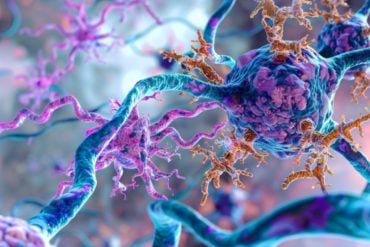Summary: A newly developed drug, Vorasidenib, has shown promise in prolonging progression-free survival for patients with a subtype of glioma.
The international study found that patients taking Vorasidenib could go nearly 17 more months without their cancer worsening, postponing the need for radiation and chemotherapy. The drug specifically targets IDH1/2 mutations in recurrent grade 2 glioma, a slow-growing brain tumor often affecting younger individuals.
Key Facts:
- Vorasidenib, a dual inhibitor of mutant IDH1/2, prevents the accumulation of 2-HG, an onco-metabolite responsible for the formation and maintenance of IDH-mutant gliomas.
- The trial involved 331 patients, with the group treated with Vorasidenib showing significantly longer disease progression-free periods (average of 27.7 months) compared to the placebo group (11.1 months).
- This study is the first clinical trial to examine a targeted therapy drug specifically designed to treat brain cancer, with Vorasidenib able to cross the blood-brain barrier.
Source: UCLA
In an international study co-led by UCLA, scientists have shown that a new targeted therapy drug can extend the amount of time people with a subtype of glioma are on treatment without their cancer worsening.
The finding suggests a possible new treatment option for people with the slow-growing but deadly brain tumor.
The team found the drug vorasidenib more than doubled progression-free survival in people with recurrent grade 2 glioma with IDH1 and IDH2 mutations. Compared with people who received a placebo, those who took vorasidenib went for nearly 17 more months without their cancer worsening, delaying the time before they needed to begin chemotherapy and radiation.
The results were published in the New England Journal of Medicine and presented today at the annual meeting of the American Society Clinical Oncology in Chicago.

The type of glioma studied in the paper, recurrent grade 2 glioma with IDH1 and IDH2 mutations, tends to affect younger people, often those in their 30s.
The current standard treatment, a combination of radiation and chemotherapy, can cause neurological deficits that make it hard for patients to learn, remember new things, concentrate or make everyday decisions — all of which can be especially challenging for people who have young families or are in the early years of their professional lives.
Dr. Timothy Cloughesy, a professor of neuro-oncology at the David Geffen School of Medicine at UCLA and co-senior author of the study, said the availability of a treatment that enables patients to go for longer periods of time between chemotherapy and radiation treatments could have a major impact.
“We’re always concerned about the delayed effects of radiation,” said Cloughesy, who is also a member of the UCLA Jonsson Comprehensive Cancer Center.
“Having the ability to hold off on getting radiation therapy to the brain with an effective therapy is really critical and very meaningful to this population of patients.”
Vorasidenib is classified as a dual inhibitor of mutant IDH1/2, meaning that it prevents the formation and accumulation of the onco-metabolite 2-Hydroxyglutarate, or 2-HG, that occurs when genetically altered versions of two enzymes, IDH1 and IDH2, are present in a tumor. 2-HG is thought to be responsible for the formation and maintenance of IDH-mutant gliomas.
The study is also the first clinical trial to analyze a targeted therapy drug specifically developed to treat brain cancer.
Targeted therapies are designed to target specific molecules that are involved in the growth and spread of cancer cells. Unlike chemotherapy and other therapies that can affect both cancerous and healthy cells, targeted therapies only attack cancer cells with the mutated target while minimizing damage to normal cells.
While there has been great progress in using targeted therapies to treat many types of cancer, development of targeted therapies for brain tumors has been especially challenging because of the difficulty of getting through the blood-brain barrier. Vorasidenib is a brain-penetrant inhibitor, which means that it has the ability to cross the blood-brain barrier.
The study involved 331 people aged 12 and older who had been diagnosed with recurrent grade 2 glioma with the IDH1 and IDH2 mutations and who had undergone brain tumor surgery. From that group, 168 were randomly assigned to receive vorasidenib and 163 received placebos.
Among those who received vorasidenib, the disease did not progress for an average of 27.7 months, significantly longer than the 11.1 months for those who received the placebo. And among those who received vorasidenib, 85.6% went for 18 months before their next treatment, while 83.4% went for 24 months between treatments.
The disease progressed in just 28% of people receiving vorasidenib, compared to 54% of those receiving placebos. And as of September 2022, which was 30 months after the study began, 72% of patients who were in the vorasidenib group were still taking the drug and their disease had not progressed.
For patients who were originally in the placebo group whose cancer began to progress during the study, doctors permitted a switch to vorasidenib. The researchers observed limited adverse side effects from vorasidenib.
“This is the first targeted treatment that shows unequivocal efficacy in this population and is precedent-setting for this disease,” Cloughesy said.
Benjamin Ellingson, director of the UCLA Brain Tumor Imaging Laboratory and a member of the Jonsson Cancer Center, was a key participant in the research that led to the clinical trial. He was involved in the radiographic evaluation of tumors in the study, which confirmed that there was a benefit of the targeted therapy.
The study’s first author is Dr. Ingo Mellinghoff of Memorial Sloan-Kettering Cancer Center. The co-senior author is Dr. Patrick Wen of the Dana-Farber Cancer Institute.
The study was sponsored by Servier Pharmaceuticals, which manufactures vorasidenib. The drug has not yet been approved by the FDA for clinical use.
About this brain cancer research news
Author: Denise Heady
Source: UCLA
Contact; Denise Heady – UCLA
Image: The image is credited to Neuroscience News
Original Research: Closed access.
“Vorasidenib in IDH1- or IDH2-mutant Low-Grade Glioma” by Timothy Cloughesy et al. NEJM
Abstract
Vorasidenib in IDH1- or IDH2-mutant Low-Grade Glioma
BACKGROUND
Isocitrate dehydrogenase (IDH)–mutant grade 2 gliomas are malignant brain tumors that cause considerable disability and premature death. Vorasidenib, an oral brain-penetrant inhibitor of mutant IDH1 and IDH2 enzymes, showed preliminary activity in IDH-mutant gliomas.
METHODS
In a double-blind, phase 3 trial, we randomly assigned patients with residual or recurrent grade 2 IDH-mutant glioma who had undergone no previous treatment other than surgery to receive either oral vorasidenib (40 mg once daily) or matched placebo in 28-day cycles. The primary end point was imaging-based progression-free survival according to blinded assessment by an independent review committee. The key secondary end point was the time to the next anticancer intervention. Crossover to vorasidenib from placebo was permitted on confirmation of imaging-based disease progression. Safety was also assessed.
RESULTS
A total of 331 patients were assigned to receive vorasidenib (168 patients) or placebo (163 patients). At a median follow-up of 14.2 months, 226 patients (68.3%) were continuing to receive vorasidenib or placebo. Progression-free survival was significantly improved in the vorasidenib group as compared with the placebo group (median progression-free survival, 27.7 months vs. 11.1 months; hazard ratio for disease progression or death, 0.39; 95% confidence interval [CI], 0.27 to 0.56; P<0.001).
The time to the next intervention was significantly improved in the vorasidenib group as compared with the placebo group (hazard ratio, 0.26; 95% CI, 0.15 to 0.43; P<0.001). Adverse events of grade 3 or higher occurred in 22.8% of the patients who received vorasidenib and in 13.5% of those who received placebo. An increased alanine aminotransferase level of grade 3 or higher occurred in 9.6% of the patients who received vorasidenib and in no patients who received placebo.
CONCLUSIONS
In patients with grade 2 IDH-mutant glioma, vorasidenib significantly improved progression-free survival and delayed the time to the next intervention. (Funded by Servier; INDIGO ClinicalTrials.gov number, NCT04164901. opens in new tab.)






